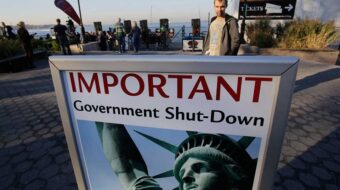Earlier this week Stockton, Calif., population 292,000, became the largest U.S. city to file for bankruptcy. The June 28 filing came after months of talks with creditors failed to resolve a $26 million gap in the city’s budget for the coming fiscal year.
Earlier in the week, the City Council had voted to halt bond payments, drastically cut workers’ health and retirement benefits, and approve a minimum budget.
“We are extremely disappointed that we have been unable to avoid bankruptcy,” Mayor Ann Johnston said in a statement. “This is what we must do to get our fiscal house in order and protect the safety and welfare of our citizens.”
The city had already defaulted on some $2 million in debt this year, resulting in creditors seizing the building that was to become the new city hall, as well as three city parking garages.
Stockton, in the midst of California’s Central Valley, is a major port handling the region’s agricultural exports. The city experienced a housing boom in the 1990s and early 2000s, as it attracted many people priced out when housing costs soared in San Francisco and other Bay Area cities.
Now has the second-highest foreclosure rate in the country. Unemployment has soared to 16 percent, far higher than the state’s current 10.8 official rate.
In recent years Stockton has slashed $90 million from its general fund, made big cuts to police and fire departments, and slashed pay and benefits for all its workers.
Much media commentary on the city’s crisis has placed blame on a building spree during the real estate boom, and on allegedly lavish benefits granted city workers.
“This is a crisis that is being turned into an opportunity to beat up on public servants,” Joe Rose, general counsel for the Stockton City Employees Association, said in a telephone interview. “The problem is not luxurious or lavish compensation for employees” but the soaring foreclosure rate and plummeting property taxes.
The city had made a commitment to its workers – many of them hired before 1986 and therefore not covered by Medicare – to fund retirement medical care, Rose said. In return, the workers agreed to take 20 percent less in salary adjustments, with the funds to be set aside to pay for the care.
“But city leaders never put that money aside, and now, because the plan was to pay those costs forward year by year, the city has a massive unfunded liability.”
At the City Council meeting, workers highlighted the bankruptcy’s cost to them. Retired police officer Gary Jones, diagnosed with brain cancer a decade ago, said the action “might well be a life sentence.” He said he would not be able to afford the chemotherapy and other treatments he needs at the new lower level of coverage.
Another side of Stockton’s crisis is illustrated by a new report from the Pew Charitable Trust’s American Cities Project. The report points out that over the country as a whole, property taxes and state aid together make up over half of the revenue of cities and other local governments, and notes that in 2010, the State of California’s aid to local governments plunged by more than $5.7 billion.
Further complicating the picture, California’s 1978 voter initiative, Prop. 13, has essentially frozen property taxes. Democratic legislators have repeatedly called for a “split roll” that would protect individual homeowners while permitting commercial real estate taxes to rise when property is transferred, but Republican legislators have blocked the moves.

MOST POPULAR TODAY

High Court essentially bans demonstrations, freedom of assembly in Deep South

Resource wars rage in eastern Congo, but U.S. capitalism only sees investment opportunity

U.S. imperialism’s ‘ironclad’ support for Israel increases fascist danger at home

UN warns that Israel is still blocking humanitarian aid to Gaza







Comments